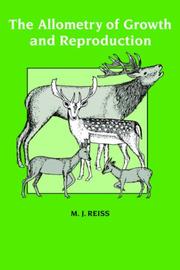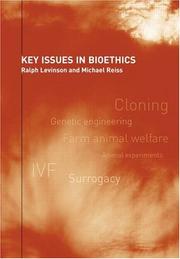| Listing 1 - 10 of 27 | << page >> |
Sort by
|
Book
ISBN: 0335157602 Year: 1993 Publisher: Buckingham : Open university press,
Abstract | Keywords | Export | Availability | Bookmark
 Loading...
Loading...Choose an application
- Reference Manager
- EndNote
- RefWorks (Direct export to RefWorks)
Lerarenopleiding --- Pluralism (Social sciences). --- Science --- (vak)didactiek wetenschappen. --- Study and teaching --- Social aspects. --- Study and teaching.

ISBN: 0521360919 9780521360913 9780511608483 9780521423588 Year: 1989 Publisher: Cambridge Cambridge University Press
Abstract | Keywords | Export | Availability | Bookmark
 Loading...
Loading...Choose an application
- Reference Manager
- EndNote
- RefWorks (Direct export to RefWorks)
Allometry --- Growth --- Reproduction --- Body Constitution
Book
Abstract | Keywords | Export | Availability | Bookmark
 Loading...
Loading...Choose an application
- Reference Manager
- EndNote
- RefWorks (Direct export to RefWorks)
Book
ISBN: 0511608489 Year: 1989 Publisher: Cambridge : Cambridge University Press,
Abstract | Keywords | Export | Availability | Bookmark
 Loading...
Loading...Choose an application
- Reference Manager
- EndNote
- RefWorks (Direct export to RefWorks)
The technique of allometry investigates the effects of size on such variables as food intake, energy requirements, growth rates and age at first reproduction. This book brings together much of what is known about the consequences of size and provides a new and mathematically rigorous framework within which many quantitative predictions are made and tested using published and unpublished data. Explanations are proposed for many previously unexplained phenomena such as why in some species females are thousands of times heavier than males, whereas in no species are males more than about eight times heavier than females. The models presented afford a synthesis of the effects of size and open up pathways for further theoretical investigation and experimental testing. Care has been taken to give verbal presentations of all the mathematical conclusions to ensure that the text is widely intelligible.
Allometry. --- Growth. --- Reproduction.
Book
ISBN: 3319689096 3319689088 Year: 2018 Publisher: Cham : Springer International Publishing : Imprint: Springer,
Abstract | Keywords | Export | Availability | Bookmark
 Loading...
Loading...Choose an application
- Reference Manager
- EndNote
- RefWorks (Direct export to RefWorks)
This salient text presents a culturally aware public health approach to the HIV epidemic in Malaysia, a country emblematic of the Muslim world's response to the crisis. It explores complex interactions of religion with health as a source of coping as well as stigma and denial, particularly as Islam plays a central role in Malaysian culture, politics, and policy. At the heart of the book, a groundbreaking study analyzes attitudes and behaviors toward prevention among diverse people living with HIV, faith leaders, and government health officials. From these findings, readers gain insight into how health professionals, policymakers, and organizations can create appropriate prevention programs in Malaysia, with implications for other Muslim countries. This timely volume: Situates Malaysia and the Asian Pacific region in the context of the HIV epidemic. Analyzes ways Islamic beliefs can shape perceptions of HIV and prevention policy. Reviews a unique study of stakeholder opinions and practices regarding HIV. Discusses the consequences of Islamic rulings on sex outside marriage. Offers recommendations for effective HIV prevention practice and policy. Islam and Health Policies Related to HIV Prevention in Malaysia is of immediate relevance to researchers studying HIV prevention, social aspects of religion, sexuality, and sex education. Policymakers in health promotion and health education as well as graduate students in sex education, sociology, psychology, and cultural studies should also find it useful.
Medicine. --- Islam. --- Health --- Health promotion. --- Medicine & Public Health. --- Health Promotion and Disease Prevention. --- Religion and Health. --- Health Policy. --- Religious aspects. --- HIV infections --- HIV (Viruses) infections --- HTLV-III infections --- HTLV-III-LAV infections --- Human T-lymphotropic virus III infections --- Lentivirus infections --- Sexually transmitted diseases --- Health-Religious aspects. --- Medical policy. --- Mohammedanism --- Muhammadanism --- Muslimism --- Mussulmanism --- Religions --- Muslims --- Health care policy --- Health policy --- Medical care --- Medicine and state --- Policy, Medical --- Public health --- Public health policy --- State and medicine --- Science and state --- Social policy --- Clinical sciences --- Medical profession --- Human biology --- Life sciences --- Medical sciences --- Pathology --- Physicians --- Government policy --- Health Workforce --- Health—Religious aspects. --- Health promotion programs --- Health promotion services --- Promotion of health --- Wellness programs --- Preventive health services --- Health education
Book
ISBN: 3030146979 3030146987 Year: 2019 Publisher: Cham : Springer International Publishing : Imprint: Springer,
Abstract | Keywords | Export | Availability | Bookmark
 Loading...
Loading...Choose an application
- Reference Manager
- EndNote
- RefWorks (Direct export to RefWorks)
This collection presents research-based interventions using existing knowledge to produce new pedagogies to teach evolution to learners more successfully, whether in schools or elsewhere. ‘Success’ here is measured as cognitive gains, as acceptance of evolution or an increased desire to continue to learn about it. Aside from introductory and concluding chapters by the editors, each chapter consists of a research-based intervention intended to enable evolution to be taught successfully; all these interventions have been researched and evaluated by the chapters’ authors and the findings are presented along with discussions of the implications. The result is an important compendium of studies from around the word conducted both inside and outside of school. The volume is unique and provides an essential reference point and platform for future work for the foreseeable future. .
Evolutionary developmental biology. --- Science --- Evolution (Biology). --- Science Education. --- Learning & Instruction. --- Teaching and Teacher Education. --- Evolutionary Biology. --- Study and teaching. --- Animal evolution --- Animals --- Biological evolution --- Darwinism --- Evolutionary biology --- Evolutionary science --- Origin of species --- Biology --- Evolution --- Biological fitness --- Homoplasy --- Natural selection --- Phylogeny --- Science education --- Scientific education --- Science education. --- Learning. --- Instruction. --- Teaching. --- Evolutionary biology. --- Didactics --- Instruction --- Pedagogy --- School teaching --- Schoolteaching --- Education --- Instructional systems --- Pedagogical content knowledge --- Training --- Learning process --- Comprehension --- Evolution (Biology)
Book
ISBN: 3030246868 303024685X Year: 2019 Publisher: Cham : Springer International Publishing : Imprint: Springer,
Abstract | Keywords | Export | Availability | Bookmark
 Loading...
Loading...Choose an application
- Reference Manager
- EndNote
- RefWorks (Direct export to RefWorks)
This book reports on a study on physics problem solving in real classrooms situations. Problem solving plays a pivotal role in the physics curriculum at all levels. However, physics students’ performance in problem solving all too often remains limited to basic routine problems, with evidence of poor performance in solving problems that go beyond equation retrieval and substitution. Adopting an action research methodology, the study bridges the `research-practical divide´ by explicitly teaching physics problem-solving strategies through collaborative group problem-solving sessions embedded within the curriculum. Data were collected using external assessments and video recordings of individual and collaborative group problem-solving sessions by 16-18 year-olds. The analysis revealed a positive shift in the students’ problem-solving patterns, both at group and individual level. Students demonstrated a deliberate, well-planned deployment of the taught strategies. The marked positive shifts in collaborative competences, cognitive competences, metacognitive processing and increased self-efficacy are positively correlated with attainment in problem solving in physics. However, this shift proved to be due to different mechanisms triggered in the different students.
Science education. --- Teaching. --- Physics. --- Learning. --- Instruction. --- Study Skills. --- Education—Research. --- Science Education. --- Teaching and Teacher Education. --- Physics, general. --- Learning & Instruction. --- Study and Learning Skills. --- Research Methods in Education. --- How to study --- Learning, Art of --- Method of study --- Study, Method of --- Study methods --- Life skills --- Learning process --- Comprehension --- Education --- Natural philosophy --- Philosophy, Natural --- Physical sciences --- Dynamics --- Didactics --- Instruction --- Pedagogy --- School teaching --- Schoolteaching --- Instructional systems --- Pedagogical content knowledge --- Training --- Science education --- Scientific education --- Physics --- Study and teaching.

ISBN: 1134489277 0203475747 1280062509 9786610062508 0203464532 9780203464533 0415270685 041530914X 9781134489220 9781134489268 9781134489275 9780415309141 9780415270687 1134489269 1134489226 Year: 2003 Publisher: London New York RoutledgeFalmer
Abstract | Keywords | Export | Availability | Bookmark
 Loading...
Loading...Choose an application
- Reference Manager
- EndNote
- RefWorks (Direct export to RefWorks)
Young people are increasingly being exposed to the huge and complex ethical dilemmas involved in issues such as genetic modification, animal rights and cloning, and they are bringing their views into the classroom. But how can teachers be sure they are sufficiently well-informed to help their pupils make sense of the diverse and emotive arguments surrounding these issues?This book holds the answer. Written by leading ethicists, scientists and technologists, it offers a balanced and jargon-free guide to such highly debated topics as:* cloning* in vitro fertilisation* ge
Bioethics --- Science --- Science and ethics --- Study and teaching. --- Moral and ethical aspects.
Book
ISBN: 9783030146986 3030146987 Year: 2019 Publisher: Cham : Springer International Publishing : Imprint: Springer,
Abstract | Keywords | Export | Availability | Bookmark
 Loading...
Loading...Choose an application
- Reference Manager
- EndNote
- RefWorks (Direct export to RefWorks)
This collection presents research-based interventions using existing knowledge to produce new pedagogies to teach evolution to learners more successfully, whether in schools or elsewhere. ‘Success’ here is measured as cognitive gains, as acceptance of evolution or an increased desire to continue to learn about it. Aside from introductory and concluding chapters by the editors, each chapter consists of a research-based intervention intended to enable evolution to be taught successfully; all these interventions have been researched and evaluated by the chapters’ authors and the findings are presented along with discussions of the implications. The result is an important compendium of studies from around the word conducted both inside and outside of school. The volume is unique and provides an essential reference point and platform for future work for the foreseeable future. .
Science --- Learning, Psychology of. --- Teachers --- Evolution (Biology) --- Science Education. --- Instructional Psychology. --- Teaching and Teacher Education. --- Evolutionary Biology. --- Study and teaching. --- Training of.
Book
ISBN: 9783030246860 3030246868 Year: 2019 Publisher: Cham : Springer International Publishing : Imprint: Springer,
Abstract | Keywords | Export | Availability | Bookmark
 Loading...
Loading...Choose an application
- Reference Manager
- EndNote
- RefWorks (Direct export to RefWorks)
This book reports on a study on physics problem solving in real classrooms situations. Problem solving plays a pivotal role in the physics curriculum at all levels. However, physics students’ performance in problem solving all too often remains limited to basic routine problems, with evidence of poor performance in solving problems that go beyond equation retrieval and substitution. Adopting an action research methodology, the study bridges the `research-practical divide´ by explicitly teaching physics problem-solving strategies through collaborative group problem-solving sessions embedded within the curriculum. Data were collected using external assessments and video recordings of individual and collaborative group problem-solving sessions by 16-18 year-olds. The analysis revealed a positive shift in the students’ problem-solving patterns, both at group and individual level. Students demonstrated a deliberate, well-planned deployment of the taught strategies. The marked positiveshifts in collaborative competences, cognitive competences, metacognitive processing and increased self-efficacy are positively correlated with attainment in problem solving in physics. However, this shift proved to be due to different mechanisms triggered in the different students.
Science --- Teachers --- Physics. --- Astronomy. --- Learning, Psychology of. --- Study skills. --- Education --- Science Education. --- Teaching and Teacher Education. --- Physics and Astronomy. --- Instructional Psychology. --- Study and Learning Skills. --- Research Methods in Education. --- Study and teaching. --- Training of. --- Research.
| Listing 1 - 10 of 27 | << page >> |
Sort by
|

 Search
Search Feedback
Feedback About UniCat
About UniCat  Help
Help News
News